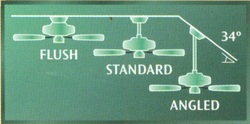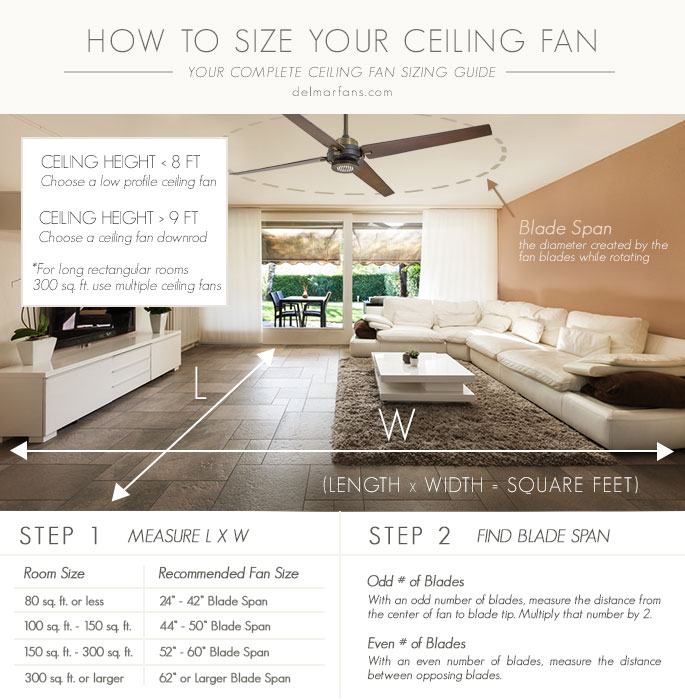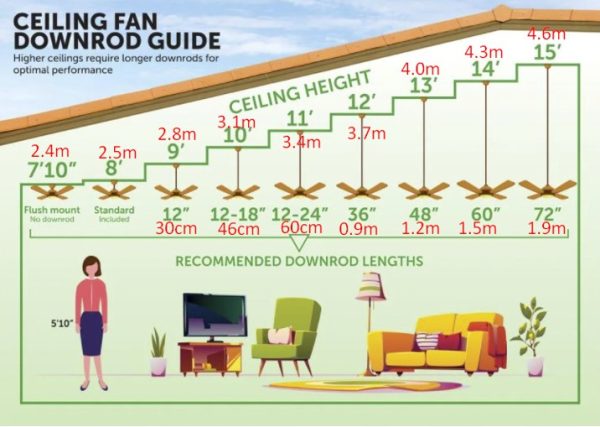Selecting The Perfect Ceiling Fan
Choosing the Perfect Ceiling Fan
Follow these simple steps to get the perfect ceiling fan that you will be really happy with and last for years reliably.
- Ceiling Fan Selection Guide – Read our guide below to understand the basics and ensure you get the correct size blades and motor.
- Read our essential ceiling fan facts page to understand the relevant considerations.
- Research our resources – Browse through our case studies, galleries, catalogues, testimonials, product reviews, videos and blogs to get some ideas of what styles you like. Familiarise yourself with the brands we stock and what type of fan you want, for example a contemporary solid-wood bladed fan with low energy DC motor or a more traditional style with flat blades and AC type motor.
- Go to our Shop page – On the menu above and use the filters on the left to explore your choices and to find specific models of interest. Then click on each product in the shortlist for detailed information, full size pictures and specifications including data sheets and installation instructions.
- Call our Sales Line – If you are not sure of anything or have any questions please just call our sales line above to talk to our highly knowledgeable staff who have been selling ceiling fans for over 15 years now.
- Place your order – Either over the phone or securely online. It should be delivered within a few working days depending on whether it is in stock in our UK warehouse (in which case next day FEDEX) or needs to come from our German warehouse (DHL/APC).
For any problems before, during or after your purchase we are here to help ensure that you become a satisfied customer. It’s what we pride ourselves on doing, and have been doing it for over 25 years now!
What fan motor and blade size do you need?
The size of ceiling fan blades that you require is based on the size of the room you have. It is important to choose the right size for the proper combination of visual style, comfort and efficiency. The larger the room the larger the fan. If you have a bigger room than 300 ft2 then you will need multiple large fans. Depending on the room shape you should aim to use them no more than 15 ft/5m between centres. Use this handy calculator from Delmar Fans to work out what size you need. If you are unsure then always buy a slightly larger fan so you can maximise your comfort in terms of airflow and sound plus get better energy consumption by running the fan at lower to medium speeds.
Beware Motor sizes – There is not very much choice within a brand or model as most motors are specified to operate the blade sizes given. Some of the larger fans in terms of both blade size and airflow (m3/h or cubic feet per min cfm) will have larger motors. The better quality DC fans like our Henley Zephyr and Falcon ranges have more powerful motors but slimline physical sizes due to the better quality components using copper-wire and silicon-steel laminates.
The Zephyr motor is specified at 60 watts but limited to 30 watts to ensure optimum performance (in terms of temperature and energy use) and long reliability in a variety of environments. Likewise the Falcon is specified at 46 watts but limited to 35 watts maximum for the same reasons. Beware of cheaper brands that have a lower specified motor power of 30 watts or even lower which are run at either a low speeds and so less air is moved in terms of m3/h or else they are run at the maximum design power which will inevitably lead to reliability issues due to overworking the motor. They will also use cheaper aluminium wire which is not as efficient or long-lasting as copper.
What style and colour do you prefer?
For a coordinated interior design look match your blade colour to your furniture or moulding finish. Alternatively match the motor body finish (which are normally metallic) to your door or cabinet hardware. Some fan blades have different patterns or colours on each side and so can be switched if needed. Blades are not normally sold separately they are pre-matched with the motor finish in the box. If you have an existing fan and wish to change the colour then you can sometimes buy new blades separately.
Where are you going to mount your fan?
This depends on how high your ceiling is and whether it is angled or not.
A. Standard Ceilings

B. Low Ceilings
There are a number of models that dispense with the usual drop rod to hang the motor with (which adds about 9″ to the drop) and use a close-coupled system with the motor can. These are called Hugger, Low Profile or Flush-Mounted ceiling fans and most brands provide this choice.
B. Angled Ceilings
If you are mounting on a sloping ceiling then check the limits as often the maximum angle that can be handled is around 34° this is due to the drop-rod hitting the canopy. Modifications can be made to the canopy to allow a steeper angle or else use of a cross-member or wooden mounting block.
What size down rod do you need?
A ceiling fan motor should operate at a height of 2.4m or 7ft 10″ for optimum operation and efficiency. A few inches more will not matter much but if your ceiling is higher than 9 ft then you will definitely need a drop rod (also known as down rod or extension rod) to bring the fan down to its optimum operational height. These are threaded hollow steel rods through which the wiring needs to pass to go to the fan (and light if used) itself. Some drop rods come with the wiring pre-installed but most require an extension to be fitted on installation. These rods take the whole weight of the fan and are secured by cotter pins or threads or both to ensure that they don’t shake loose over time – these pins must not be substituted by screws that will shake loose.
You will require ft for ft a rod for each ft over 9ft, eg a 12ft ceiling will require a 3ft drop rod. The maximum angle that a drop rod can operate at is 34 ° so if you have vaulted ceilings or alcoves then you might need to mount the fan on a solid cross-member rather than the roof itself. The following picture gives a quick guide to the length of drop rod you need. For more info on drop rods and wobbling fans go to any of our drop rod product pages.
Suspended ceilings – If you are mounting the fan in a room with a suspended ceiling then you will need to either affix the mounting bracket onto the solid ceiling above it and then feed the down rod through the ceiling or else purchase a steel mounting bracket that are adjustable to the height of the suspended part onto which the mounting bracket can be firmly fixed.
Do you need a ceiling fan light kit?
Latest LED light kits – Some fans come with lights built in and some can have them added separately. These days the designs are all with LED lights and the latest fashion is for 3 colour temperature whites ie pure white, warm white and daylight that can be selected from the remote control (eg our Falcon LED does this).
Light kit glasses – The best ones are made of frosted toughened glass which diffuse the light evenly. The lower cost ones are made from polycarbonate. It is hard to tell the difference once they are up.
Traditional light kits – The older style ceiling fans will use normal lights but will work with low energy bulbs. There is a huge choice of kits, glasses and bulbs so you can pick something that fits your existing room style or if it is a new room then a light that makes the whole ceiling fan the focus of the ceiling.
How do you want to control the fan?
Ceiling fans (and their accompanying lights) can be controlled by 3 methods:
- Pull chains – These are small chains that dangles from the fan motor body with a small key on the end called, not surprisingly, a “fandangle”. They are only used on cheaper AC fans. By pulling the chain consecutively it will cycle through the speed settings. There are normally 3 speeds on an AC fan which are controlled by capacitors which also start and stop the fan. Modern DC fans use more sophisticated motor control technology and typically have 6 speeds. Pull chains are only suitable if the fan is at a standard or low height.
- Wall controls – These can be located next to your normal light switch. They can be used either directly to control the fan and the light (although you will need to run 4 core wiring to the provide an additional “switched live” to turn the light on/off) or also be used to isolate or be a master switch when using a remote control. The DC fans are now introducing battery powered wall controls that means you don’t have to worry about loosing the remote and also don’t need dedicated wiring as they work by wifi. One useful thing to consider is does the fan remember the speed settings so that it can be simply wired via a wall on/off switch. This is useful for hotels but is also handy for offices where the speed can be left as the same setting and fan operated just like a light switch.
- Remote controls – These are now the most popular way to control the fan. Some controls are very sophisticated and can be set with timers and even thermostats to switch the fans on automatically. The control comes in 2 parts, the receiver and the handset remote. The receiver sits either inside the fan canopy in the case of AC fans, or in the motor assembly in the case of DC fans. The remote is battery powered and has dip switches so that different fans in the same room can be controlled by different remotes using different radio frequency channels.
- Reversible Motors – Most fans can also be run in reverse in the winter to bring trapped heat down from a ceiling to floor level saving energy. The normal direction of a ceiling fan in summer is anticlockwise and there is a slide switch located on the body of the motor that can reverse the direction on AC fans to be clockwise and on DC fans it is on the handset.
- Simulated breezes – Many DC fans have a simulated breeze option which varies the motor speed to simulate a breeze. This is a bit of a gimmick but can be quite nice.
How long a warranty do you need?
Hopefully nothing will go wrong with your ceiling fan but we all live in the real world where with the best will things can and do go wrong! We also all know that you get what you pay for and so it is impossible for a fan costing £50 to be of a similar quality to one of £350. The law provides for warranties of 1 year and many cheap fans only just make it past that milestone before they start humming, buzzing, wobbling and the finishes start to tarnish and peel.
It is a false economy to purchase a cheap fan since the labour costs to swop it out will dwarf the fan cost. It is far better to get something decent that is built to last (at least for the foreseeable future of 3-5 years minimum) and do the job without any hassle. A longer motor warranty goes hand-in-hand with a better quality manufacturer so whilst 25 years or lifetime sounds too long it is only offered by brands that stand behind their quality (or by companies that don’t intend to stay around long enough to honour them).
It is best to have peace-of-mind knowing that if you do encounter problems then we are here to provide support, spares if needed and ultimately to replace the motor if needed free-of-charge. Most of the fans we sell have a Lifetime Motor Warranty which covers it against defects in manufacture – Note that it doesn’t cover for physical, electrical or other damage. The other fans we sell all have a minimum of 10 years warranty even if the manufacturer only provides 5 years or even 2 years. We think it is worth it as your time is valuable and you really don’t want to have the hassle and expense of dealing with faults or living with annoying noises, buzzes and wobbles.


